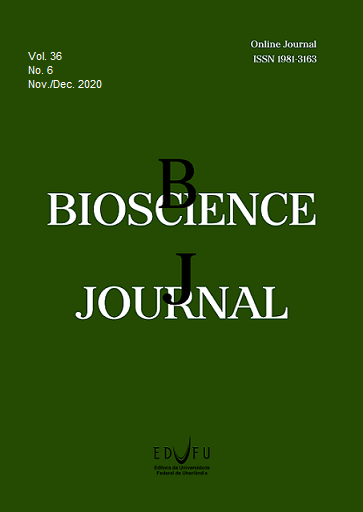A comparative study of the antifungal activity of essential oils of Varronia curassavica Jacq. obtained by different distillation methods
DOI:
https://doi.org/10.14393/BJ-v36n6a2020-47869Keywords:
Erva-baleeira., Volatile oils., Extraction Methods., Colletrotrichum musae.Abstract
This work aimed to compare the antifungal activity of the essential oil of Varronia curassavica obtained by hydrodistillation and microwave against the fungus Colletotrichum musae and verify the alterations caused by these extraction methods on the leaf surface. This study used four essential oil samples obtained by different methods, two by hydrodistillation [HD1 (1.0 L of water and 100 min.) and HD2 (2.0 L of water and 140 min.)] and two by microwave [MI1 (500W, 20 min, without water) and MI2 (700W, 40 min, with 50 mL of water added to fresh leaves)]. Essential oils concentrations of 0.05, 0.1, 0.5, 1.0, and 3.0% (v / v) were tested in PDA medium. The mycelial growth of C. musae was evaluated by measuring the diameter, every 24 hours up to 144 hours after the beginning of the incubation. Untreated leaves and leaves treated with HD1 and MI1 were prepared for observation in a scanning electron microscope (SEM) LEO EVO 40. The most abundant compounds detected in the essential oil samples analyzed by gas chromatography were: shyobunol, germacrene D-4-ol, E-caryophyllene, bicyclogermacrene, and α-cadinol. Up to 72 hours after the beginning of the incubation, C. musae presented no mycelial growth, even at the lowest essential oil concentration. Conversely, mycelial growth was detected in the control (PDA + DMSO) from 24 hours after incubation. At 144 hours after incubation, regardless of the concentration, the essential oil samples obtained by HD provided lower mycelial growth of C. musae (1.49 cm) when compared with samples obtained by MI (1.80 cm). This difference possibly occurred due to the reduction to less than half of the germacrene D-4-ol content in the samples obtained by MI. The four essential oil samples tested inhibited the mycelial growth and thus presented a inhibitory effect on C. musae. The SEM revealed more drastic changes on the surface of the leaf treated with MI than on those treated with HD. The essential oil of V. curassavica, mainly when obtained by hydrodistillation, has the potential for use in the control of C. musae.
Downloads
Published
Issue
Section
License
Copyright (c) 2020 Daniela Aparecida de Castro Nizio, Arie Fitzgerald Blank, Fabiany de Andrade Brito, Paulo Roberto Gagliardi, Eduardo Alves, Maria de Fátima Arrigoni Blank

This work is licensed under a Creative Commons Attribution 4.0 International License.





